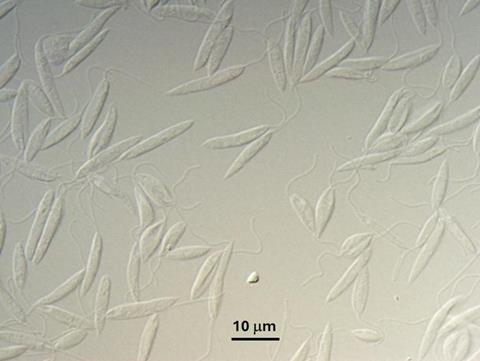A breakthrough in understanding how a single-cell parasite makes ergosterol (its version of cholesterol) could lead to more effective drugs for human leishmaniasis, a parasitic disease that afflicts about 1 million people and kills about 30,000 people around the world every year.

The findings, reported in Nature Communications, also solve a decades-long scientific puzzle that’s prevented drugmakers from successfully using azole antifungal drugs to treat visceral leishmaniasis, or VL.
About 30 years ago, scientists discovered the two species of single-cell parasites that cause VL, Leishmania donovani and Leishmania infantum, made the same lipid sterol, called ergosterol, as fungi proven susceptible to azoles antifungals. These azoles antifungals target a crucial enzyme for sterol biosynthesis, called CYP51.
While not fungi, both Leishmania species have biochemical similarities to fungi in their plasma membrane, where ergosterol helps maintain cellular integrity and supports a host of biological functions, much as cholesterol does in humans.
Sterol profile
“People looked into the sterol profile of the parasites and discovered they primarily have ergosterol,” said study corresponding author Michael Zhuo Wang, professor of pharmaceutical chemistry at the University of Kansas School of Pharmacy. “This sterol is the main component of their plasma-membrane sterols. A similar case can be observed in fungi. Fungal organisms also have a high amount of ergosterol in their membranes. There was an original instinct to use antifungal azoles to try to block that pathway.”
However, scientists were unable to effectively use antifungals against VL.
“In the research lab and some of the clinical trials, some azoles worked a little bit, and some other azoles didn’t work at all,” Wang said. “I eventually focused on this sterol pathway a scientific question — if this parasite also uses ergosterol, you’d think all the antifungal azoles would work against this parasite.”
Along these lines, Wang started his independent research career as part of a group at the University of North Carolina-Chapel Hill called the Consortium for Parasitic Drug Development.
Neglected tropical diseases
“We were interested in developing new drugs against neglected tropical diseases,” he said. “One of these diseases is leishmaniasis. The other one is the African sleeping sickness. Leishmaniasis, spread by a sandfly vector in warmer climates, can cause really devastating infection of internal organs such as the liver and the spleen, as well as the bone marrow.”
READ MORE: Study identifies potential targets for treatment of visceral leishmaniasis
READ MORE: Scientists develop an innovative compound effective against malaria and leishmaniasis
In his new scholarly paper, Wang and his collaborators have largely solved that longstanding scientific question. They show the parasites that cause leishmaniasis are vulnerable via a different pathway for biosynthesis of their ergosterol, known as the CYP5122A1 enzyme. Therefore, azole antifungals targeting the CYP5122A1 enzyme as well as the traditional CYP51 pathway should be much more effective at treating leishmaniasis.
“So those azoles don’t work very well against leishmania unless you have an azole that also inhibits the new pathway, the CYP5122A1,” Wang said. “Then, all of a sudden, they’re much more active against leishmania. That’s the main discovery in this study — we figured out the true drug target in leishmania. You really need to hit this new enzyme, 22A1, in order to stop the parasites.”
Biochemical function
Wang’s lab at KU demonstrated the CYP5122A1 gene encodes an essential sterol C4-methyl oxidase in the leishmania parasite, through extensive biochemical characterization.
“This involved defining its biochemical function — what this enzyme does in terms of sterol biosynthesis,” he said. “We pinned down its biochemical function, clarifying its role in the ergosterol biosynthesis pathway.”
Already, the researchers are publishing follow-up scholarship and discovery based on their new breakthrough in understanding the sterol synthesis pathway in the parasites. They said drugmakers and researchers should be developing therapies that target CYP5122A1. These should prove more effective at helping people survive leishmaniasis, Wang said.
“This tells us how we should repurpose these existing antifungal azoles through screening against this new target,” said the KU researcher. “The ones that actually inhibit this new target should have a better chance to work against leishmania infection.”
Collaborative effort
Wang’s co-authors at the KU School of Pharmacy were doctoral students Yiru Jin and Mei Feng, who served as lead authors, and doctoral student Lingli Qin as co-author in the Department of Pharmaceutical Chemistry; Director Chamani Perera and doctoral student Indeewara Munasinghe from KU’s Synthetic Chemical Biology Core Laboratory; Philip Gao, director of KU’s Protein Production Group; and Judy Qiju Wu, associate teaching professor of pharmacy practice.
The KU researchers were joined by Kai Zhang, Somrita Basu, Yu Ning, Robert Madden, Hannah Burks and Salma Waheed Sheikh from Texas Tech University; and Karl Werbovetz, Arline Joachim, Junan Li and April Joice from The Ohio State University.
This study was supported in part by the U.S. National Institute of Allergy and Infectious Diseases, the U.S. Department of Defense and the KU Centers of Biomedical Research Excellence (COBRE).







No comments yet